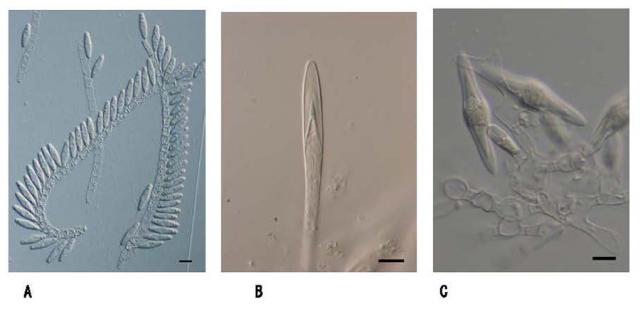Home > Research > Research Results > Research Results 2018 > Diversity of Micro-Fungi in the Guts of Insects
Update:October 5, 2018
Main content starts here.
Diversity of Micro-Fungi in the Guts of Insects
| Article title |
Three new species of Harpellales from Mount Tsukuba |
|---|---|
| Author (affiliation) |
Hiroki Sato (a), Yousuke Degawa (b) (a) Department of Forest Entomology, FFPRI, Tsukuba, Ibaraki, Japan. |
| Publication Journal |
Mycologia, 110:258-267, June 2018, https://www.tandfonline.com/doi/full/10.1080/00275514.2018.1450577( External link ) |
| Content introduction |
In surveys of insect diversity, although there may be characteristic species in a given location, there are also species that are common across multiple locations. Here we focused on organisms that parasitize insects as a standpoint from which to compare diversity between locations with many common species. Because parasitic organisms are smaller than insects, they are believed to be affected by much finer differences in the environment than insects. The intestines of insects are known to be parasitized by particular filamentous fungi. In the current study, we investigated aquatic insects inhabiting the streams of Mt. Tsukuba to determine the presence or absence of such intestine-parasitizing fungi. We scrubbed submerged rocks to free insects from rock surfaces and then collected them using nets positioned downstream. The obtained insects were dissected and their intestines were observed. As a result, different intestinal fungi were obtained from each of the three insect species surveyed. Moreover, we determined that all were new species belonging to the order Harpellales. Specifically, Stachylina philoricola was isolated from Philorus sp. (Blephariceridae: Diptera), Zygopolaropsis sphaerica from Baetis thermicus (Baetidae: Ephemeroptera), and Lancisporomyces tsukubaensis from Amphinemura sp. (Nemouridae: Plecoptera); each was recorded as a new species. We also proposed the fungus obtained from Baetis thermicus to be a new genus. Parasitic fungi represent invisible indicators of biodiversity that lay hidden within insects.
B: Lancisporomyces tsukubaensis. The genus name Lancisporomyces comes from its lance-like-spore myces, whereas the specific name tsukubaensis is derived from it “being of” (ensis) Tsukuba. The image is of a lance (spear)-shaped spore (zygospore). C: Zygopolaropsis sphaerica. The genus name Zygopolaropsis is derived from the fungus Zygopolaris that it resembles (opsis), whereas the specific name sphaerica is derived from the (spherical) portion that attaches to the intestine. The image is of a zygospore, which has the shape of a long diamond. The Zygopolaris zygospore has a triangular shape. |
Copyright © Forest Research and Management Organization. All rights reserved.

